
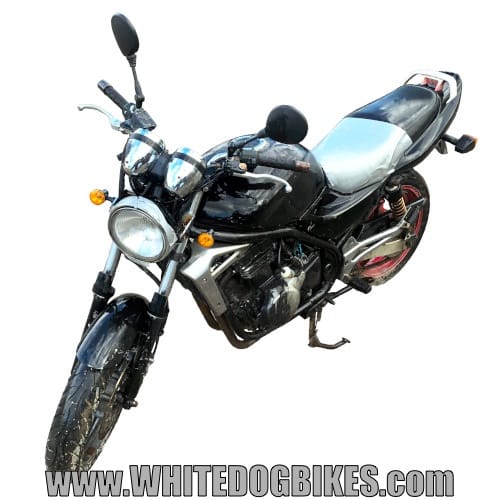
2004 Kawasaki ER-5 (yes, it’s looking a bit bruised and battered!)
Kawasaki ER5 Specs…..
The Kawasaki ER5 was a naked, 498cc budget commuter motorcycle produced by Kawasaki in the UK between 1996 and 2007.
The ER-5 used a liquid cooled engine from the GPZ500 (although the ER-5 was 49bhp while the GPZ was 59bhp) and featured twin rear shocks, 37mm front forks and double cradle frame.
The bike was built by Kawasaki on a budget so was very prone to corrosion as well as electrical faults (mainly as they got older and in the wet).
Need parts for your ER5? Kawasaki ER-5 used parts…
A little bit about the Kawasaki ER-5…..
Basic model info… |
|
|---|---|
| Manufacturer: | Kawasaki |
| Model: | ER5 |
| Model code: | ER500 |
| CC: | 498cc |
| Engine type: | Parallel-twin (4 stroke) |
| Years in production: | 1996 to 2007 |
| Style of bike: | Commuter bike |
| Insurance: | Group 8 (of 17) |
| Replaced by: | Kawasaki ER6 |
Servicing your bike? You’ll need an ER-5 workshop manual…
Models and years (in the UK) |
|
|---|---|
|
|
| ER500 A1 (Sept 1996 to Sept 1997)….. | |
| Frame number started: | JKAER500AAA00– |
| Description: | Naked budget commuter bike with 37mm front forks, 17 inch, 3 spoke wheels, single exhaust silencer and alloy radiator side covers. |
| Available colours: | Black, metallic blue or red |
| Price (new): | £3695 |
| ER500 A2 (Oct 1997 to Oct 1998)….. | |
| Frame number started: | JKAER500AAA01– |
| Description: | Same as above model with new colours. |
| Available colours: | Silver, red or blue |
| Price (new): | £3695 |
| ER500 A3 (Nov 1998 to Dec 1999)….. | |
| Frame number started: | JKAER500AAA02– |
| Description: | Same as above model with new colours. |
| Available colours: | Red, blue or pearl boulogne (kind of a blue/green colour) |
| Price (new): | £2995 to £3095 |
| ER500 A4 (Jan 2000 till Dec 2000)….. | |
| Frame number started: | JKAER500AAA04– |
| Description: | Same as above model with new colours. |
| Available colours: | Grey, blue or red |
| Price (new): | £3250 |
| ER500 C1 (Jan 2001 to Oct 2002)….. | |
| Frame number started: | JKAER500ACA0510– |
| Description: | Re styled model. |
| Available colours: | Blue, black or gold |
| Price (new): | £3295 |
| ER500 C3 (Nov 2002 to Jan 2004)….. | |
| Frame number started: | EX500C3—- |
| Description: | Same as above model. |
| Available colours: | Blue, black or gold |
| Price (new): | £3295 |
| ER500 C4P (Feb 2004 to Oct 2004)….. | |
| Frame number started: | EX500C4P—- |
| Description: | Minor detail changes. |
| Available colours: | Black or red |
| Price (new): | £3295 |
| ER500 C5P (Released Nov 2004)….. | |
| Frame number started: | |
| Description: | Same as above model. |
| Available colours: | Black or blue |
| Price (new): | £3345 |
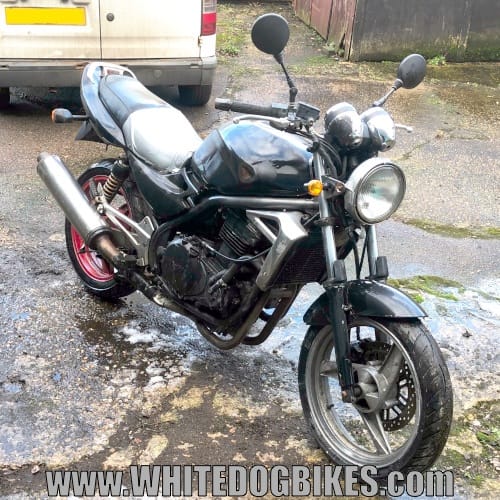
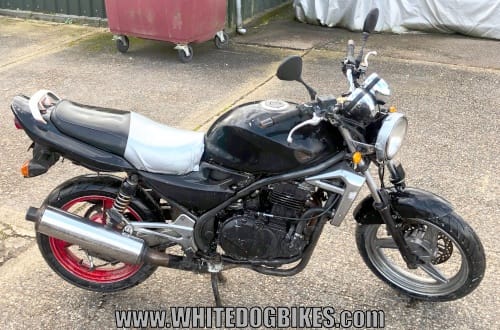

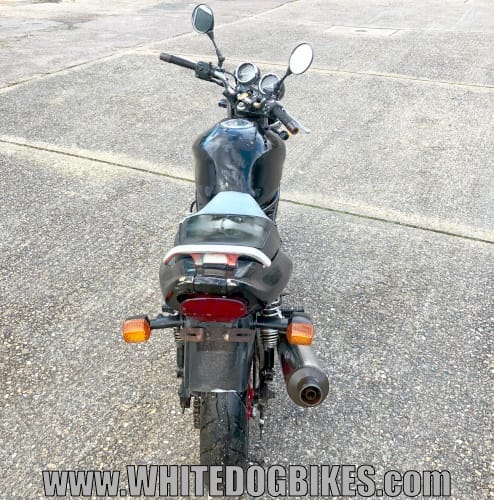


Panoramic view of the ER5 C1
Engine and gearbox specs….. |
|
|---|---|
| Displacement: | 498 cc |
| Engine type: | Parallel-twin |
|
|
| Stroke: | 4 stroke |
| Bore×Stroke: | 74x58mm |
| No. of cylinders: | 2 |
| Cam shaft configuration: | DOHC (double overhead cam) |
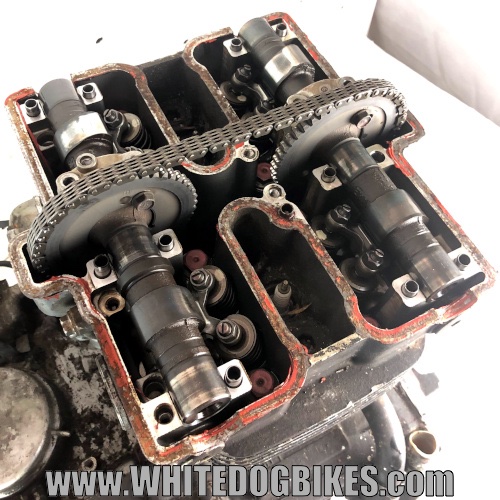 Double overhead cams in an ER5 engine |
|
|
|
| Compression ratio: | 9.8:1 |
| Cylinder compression pressure: | 9.6 to 14.7 bar (139 to 213 psi) |
| Valves: | 8 valve (4 per cylinder) |
| Spark plug: | NGK DR9EA (x2) |
| Spark plug gap: | 0.6 to 0.7mm |
| Spark plug torque: | 14nm |
| Spark plug socket size: | 18mm |
| Firing order: | 1 – 2 |
| Engine oil: | 10w40 API SG/JASO MA or higher |
|
|
| Engine oil capacity: | 3.0 litres |
| Engine oil drain bolt location: | Bottom/underneath of the engine |
| Oil filter type: | Canister type |
| Oil filter: | Hiflo HF303 / Filtrex OIF006 |
| Oil filter torque: | 10nm |
| Cooling system: | Liquid cooled |
| Cooling system capacity: | 1.7 litres |
| Clutch: | Wet (oil immersed) multiplate clutch |
| Clutch operation: | Cable |
| Clutch lever free play: | 2 to 3mm |
|
|
| Gearbox: | 6 Speed manual (1st gear down, 2nd to 6th gears up, neutral between 1st and 2nd gears) |
| BHP: | 49 bhp |
| Torque: | 33 ft/lb |
| Top speed (claimed): | 110 mph |
| 0 to 60mph time (claimed): | 5.3 seconds |
| Quater mile time (claimed): | 14.9 seconds |
|
|
| Piston ring to cylinder bore clearance: | New: 0.043mm / Max 0.070mm |
| Valve clearance (inlet): | 0.13mm to 0.18mm (when cold) |
| Valve clearance (exhaust): | 0.18mm to 0.23mm (when cold) |
| Idle speed: | 1,200rpm (+/- 50) |

2004 ER5 cylinder head cover
Note: The 2004 Kawasaki ER-5 has 2 blanking plates on the cylinder head cover. Earlier models (and some GPZ500 engines on which the ER5 engine was based) had a reed valve and pipes instead of the blanking plate that was used as a crankcase ventilation system (CVS).

ER5 side and center stands
Final drive stuff….. |
|
|---|---|
| Final drive: | Chain |
| Front sprocket: | 17 teeth |
| Engine/chain sprocket nut tightening torque: | 127nm |
| Rear sprocket: | 42 teeth |
| Rear sprocket nuts tightening torque: | 59nm |
| Chain pitch/length: | 520 pitch / 106 links |
| Chain free play: | 35 to 40mm |
| Chain stretch limit: | 317.5 to 318.2mm over 20 links |
| Chain lubrication: | Chain lube |
|
|

Kawasaki ER-5 Hiflo HF303 oil filter
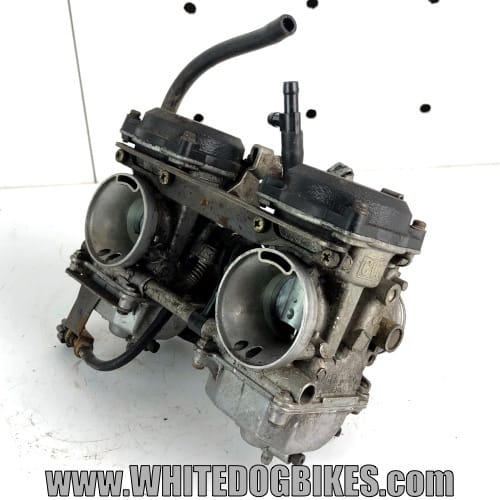
Kawasaki ER-5 inline twin carbs
Carb, fuel and oil stuff….. |
|
|---|---|
| Fuel system: | Carburetor |
| MPG (average): | 46 miles per gallon (very approx) |
| Fuel tank range (approx): | 170 miles |
|
|
| Fuel tank capacity: | 17 litres |
| Fuel type: | Unleaded petrol (95 octane grade – aka standard petrol from your local garage) |
|
|
| Carb make: | Keihin (2x) |
| Carb type: | CVK 34 (34mm flat-slide carbs) |
| Pilot screw opening: | 1 1/4 (1 and a quarter) turns |
| Engine oil: | 10w40 API SG/JASO MA or higher |
|
|
| Engine oil capacity (if just changing the oil and filtet): | 3.0 litres |
| Engine oil capacity (after a complete engine dismantle): | 3.4 litres |
| Engine oil drain bolt location: | Bottom/underneath of the engine |
| Engine oil drain bolt: | 29nm |
| Oil filter type: | Canister type |
| Oil filter: | Hiflo HF303 / Filtrex OIF006 |
| Oil filter torque: | 17nm |
|
|
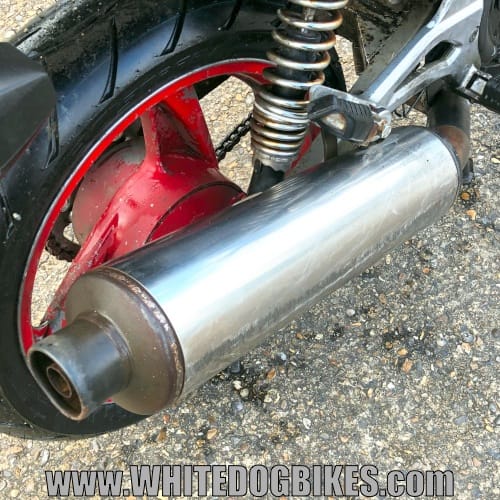
ER-5 exhaust end can

ER5 exhaust downpipes mounted on the bike

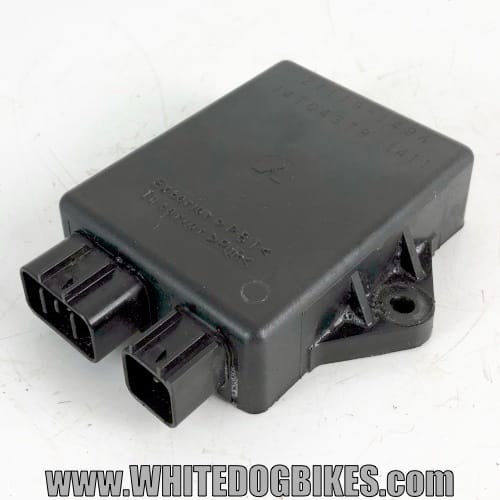
Kawasaki ER5 CDI/ignitor unit (part no: 21119-1494)
Electric stuff….. |
|
|---|---|
| Ignition type: | Electronic CDI |
| Starter: | Electric start |
| Electrical system voltage: | 12 volts |
| Battery voltage (fully charged): | 13 to 13.2 volts |
| Battery will need charging if below: | 12.6 volts |
| Regulated voltage: | 14 to 15 volts |
| Spark plug: | NGK DR9EA (x2) |
| Spark plug gap: | 0.6 to 0.7mm |
| Spark plug torque: | 14nm |
|
|
| Spark plug ignition: | 2 x coil |
| Battery type: | Sealed / maintenance free |
| Battery capacity: | 12 volts / 10 amp/hours (12v / 10ah) |
| Battery: | CTX12-BS / YTX12-BS / GTX12-BS |
|
|

Kawasaki ER-5 battery (CTX12-BS).
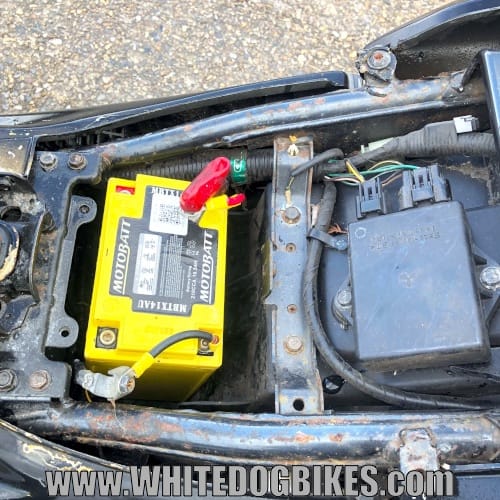
Under the ER-5 seat showing the battery compartment and CDI / ignitor unit

ER5 front wheel with 110/70-17 tyre
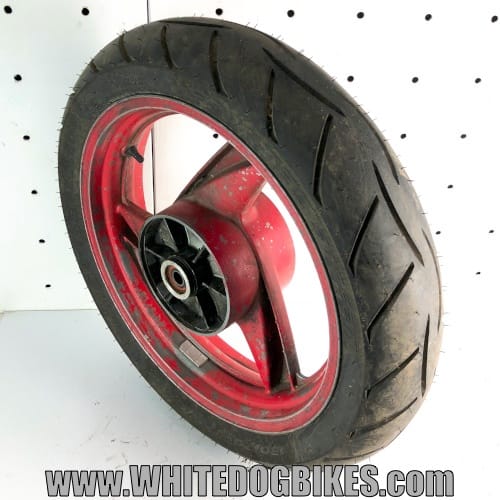
ER5 drum brake rear wheel with 130/70-17 tyre
Shocks, brakes and wheel specs….. |
|
|---|---|
| Front wheel type: | 3 spoke cast wheel |
| Front tyre size: | 110/70-17 |
| Front tyre pressure: | 32psi (2.2 bar) |
| Front wheel spindle torque: | 88nm |
| Front wheel spindle clamp bolt torque: | 20nm |
| Rear wheel type: | 3 spoke cast wheel |
| Rear tyre size: | 130/70-17 |
| Rear tyre pressure up to 97.5kg load (rider and luggage): | 36psi (2.5 bar) |
| Rear tyre pressure over 97.5kg load (rider and luggage): | 41psi (2.8 bar) |
| Rear wheel spindle torque: | 98nm |
| Front brake: | Single hydraulic disc brake with 2 piston caliper |
| Front brake disc: | 280mm single solid disc. Part no: EBC MD4016 (1x) |
| Front brake pad (1997 to 2000, A1/A2/A3/A4 models): | EBC FA129 (1x) |
| Front brake pad (2001 to 2007, C1/C3/C4P/C5P models): | EBC FA229 (1x) |
| Brake fluid (front): | DOT 4 brake fluid |
| Rear brake: | 160mm drum brake |
| Rear drum brake pad: | EBC K706 |
| Front suspension: | Telescopic forks |
| Front fork stanchion diameter: | 37mm |
| Recommended fork oil: | 10w fork oil |
| Fork oil volume (1997 to 2000, A1/A2/A3/A4 models): | 295 cm3 (per fork) |
| Fork oil volume (2001 to 2007, C1/C3/C4P/C5P models): | 298 cm3 (per fork) |
| Fork length: | 79.5cm |
| Rear Suspension: | Twin rear shock absorbers |

Kawasaki ER5 rear brake plate
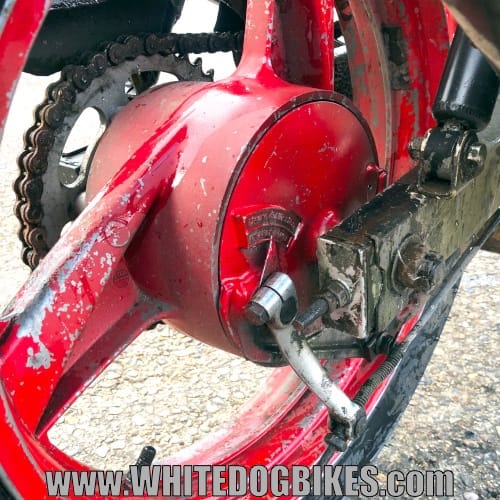
ER-5 back drum brake on bike showing activator and torque arms
Weights, measures ‘n stuff….. |
|
|---|---|
| Overall length: | 2070mm |
| Overall width: | 730mm |
| Overall height: | 1070mm |
| Wheelbase: | 1,430mm |
| Seat height: | 800mm |
| Ground clearance: | 125mm |
| Dry weight: | 179kg |
| Turning radius: | 2.5 meters |

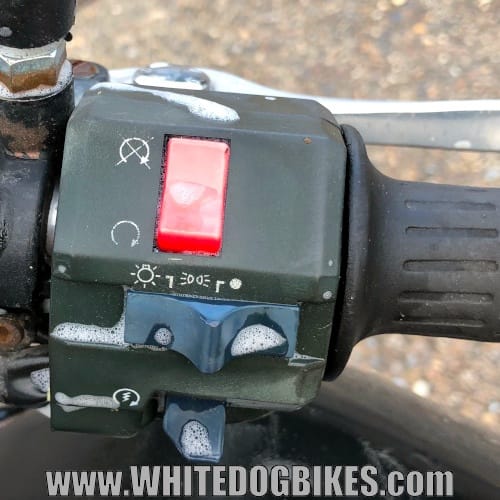
ER5 handlebar controls showing starter button, light and indicator controls
Useful torque settings….. |
|
|---|---|
| Camshaft cap bolts: | 12nm |
| Cylinder head cover bolts: | 10nm |
| Cylinder head bolts (10mm): | 51nm |
| Cylinder head bolts (6mm): | 10nm |
| Spark plugs: | 14nm |
| Front wheel spindle bolt: | 88nm |
| Front wheel spindle clamp bolts: | 20nm |
| Rear wheel spindle bolt: | 98nm |
| Engine/chain sprocket nut: | 127nm |
| Rear sprocket nuts: | 59nm |
| Magneto / flywheel: | 69nm |
| Camshaft sprocket: | 15nm |
| Clutch hub: | 132nm |
| Oil filter torque: | 17nm |
| Engine oil drain plug: | 29nm |
| Front brake caliper mounting bolts: | 34nm |
| Front brake disc mounting bolts: | 27nm |
| Front fork yoke upper stanchion allen bolts: | 20nm |
| Front fork yoke lower stanchion allen bolts: | 35nm |
| Front fork stanchion bottom allen bolt: | 20nm |
| Rear shock absorber bolts: | 34nm |
| Handlebar clamp bolts: | 25nm |
| Footpeg hanger bracket mounting bolts: | 34nm |
| Side stand bolt: | 44nm |
| Center stand bolts: | 44nm |

ER-5 seat and helmet lock location (in the left side panel, just below the seat)
Service stuff….. |
|
|---|---|
| Servicing your bike? You’ll need an ER5 workshop manual… | |
| Engine oil | |
| Engine oil change frequency: | Every 6,000km (approx 3,728 miles) or 6 months |
| Engine oil: | 10w40 API SG/JASO MA or higher |
| Engine oil capacity (if just changing the oil and filtet): | 3.0 litres |
| Engine oil capacity (after a complete engine dismantle): | 3.4 litres |
| Engine oil drain bolt location: | Bottom/underneath of the engine |
| Engine oil drain bolt: | 29nm |
| Oil filter type: | Canister type |
| Oil filter: | Hiflo HF303 / Filtrex OIF006 |
| Oil filter torque: | 17nm |
| Chain drive | |
| Chain lubrication: | Chain lube |
|
|
| Chain and sprocket size: | 106 link / 520 Pitch chain 17 Tooth front sprocket 42 Tooth rear sprocket |
| Hydraulic brake system (front) | |
| Brake fluid change frequency: | Change every 24 months or 24,000km (approx 14,912 miles) |
| Brake fluid: | DOT 4 brake fluid |
| Fork oil | |
| Front fork oil check: | 12,000km (approx 7,456 miles) or 24 months |
| Front fork oil change: | 24,000km (approx 14,912 miles) or 24 months |
| Recommended fork oil: | 10w fork oil |
| Fork oil volume (1997 to 2000, A1/A2/A3/A4 models): | 295 cm3 (per fork) |
| Fork oil volume (2001 to 2007, C1/C3/C4P/C5P models): | 298 cm3 (per fork) |
| Cooling system | |
| Change every: | 24,000km (approx 14,912 miles) or 24 months |
| Cooling system: | Liquid cooled |
| Cooling system capacity: | 1.7 litres |

ER-5 clocks showing main light beam light, neutral gear light, speedo and rev counter
Frame number location…..
The frame number is usually stamped onto the right side of the headstock (the front part of the frame just below the handle bars).
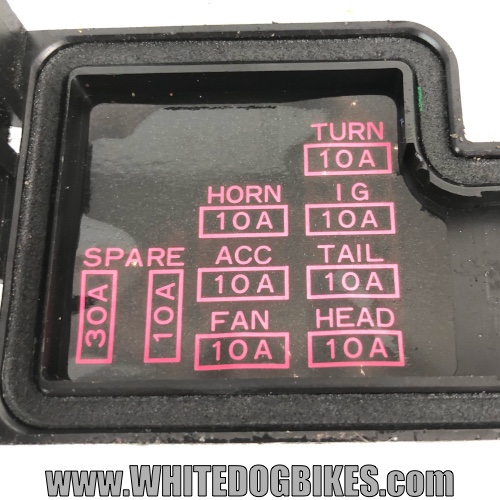
ER5 fuse box diagram showing the positions of different fuses in the fuse box
Useless stuff…..
Loved by commuters, couriers and motorcycle training schools the Kawasaki ER5 was a twin cylinder 500cc naked bike released in the UK between 1996 and 2007.
The bike was marketed as a ‘budget’ bike (with an initial retail price of £3695 in 1996, the Honda CB500 retailed for £4085) and didn’t come equipped with many (any?) luxury features.
The bike was aimed at the urban (city) and extra urban commuter and was ideal as a winter hack for owners who like to keep their pride and joy wrapped up over the winter months.
The ER-5 engine was based on the tried and tested GPZ500 engine (although it did have lower power, 49bhp opposed to 59bhp from the GPZ) and was meant as a rival for bikes like the Honda CB500.
The ER5 was economical on fuel, got good tyre life and was fairly cheap to insure making it a cheap way of commuting or for younger riders getting into biking.
Buying advice…..
There are a few things to bare in mind if your thinking of getting one of these bikes. The bike was built on a budget by Kawasaki so metal parts and other bits will be fairly corroded if it’s been used all year round or stored outside (especially without a cover).
Also, there are plenty of ex bike training school and courier bikes around which will have had a hard life and are probably best avoided.
As with alot of older Kawasaki bikes, the electrics can be a bit problematic, especially in the wet weather and the ER5 rear drum brake wheel suffered from ‘ovulation’ of the drum (where, over time, the drum wears to an ‘oval’ shape) which can cause pad rubbing or MOT failure (in a worst case scenario).
Obviously, being as the youngest of these bikes will be 17 years old now, they can suffer from the usual problems related to age (corroded fork stanchions, rusted/holed exhausts and worn rear shocks).
However, due to Kawasaki selling absolutely loads of these there are plenty of spares around in breakers and, as it shared alot of engine parts with the GPZ500S there are alot of new parts for sale.
Happy biking 🙂
Sources / Thanks to / Useful ER-5 / ER500 sites:
ER5 article on MCN
Rock oil for the servicing info
ER5 article on Wikipedia
If you’ve got any questions, comments or suggestions please feel free to leave them below 🙂
Disclaimer: The information on this page is correct to the best of our knowledge. But the info should NOT be taken as 100% accurate as we can, occasionally make mistakes!

Leave a Reply